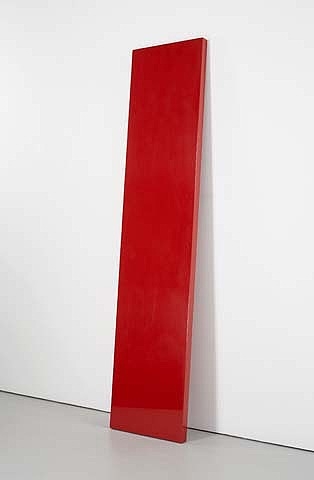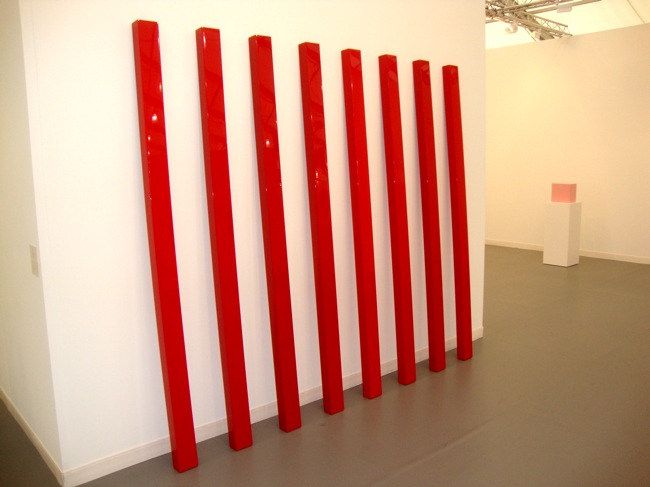Sunday, 17 November 2013
John McCracken - Planks
Red Plank, 1967
John Harvey McCracken (December 9, 1934 – April 8, 2011) was a contemporary artist who lived and worked in Santa Fe, New Mexico and New York.
In 1966, McCracken generated his signature sculptural form: the plank, a narrow, monochromatic, rectangular board format that leans at an angle against the wall (the site of painting) while simultaneously entering into the three-dimensional realm and physical space of the viewer. He conceived the plank idea in a period when artists across the stylistic spectrum were combining aspects of painting and sculpture in their work and many were experimenting with sleek, impersonal surfaces. As the artist noted, "I see the plank as existing between two worlds, the floor representing the physical world of standing objects, trees, cars, buildings, [and] human bodies, ... and the wall representing the world of the imagination, illusionist painting space, [and] human mental space." The sculptures consist of plywood forms coated with fiberglass and layers of polyester resin.
http://en.wikipedia.org/wiki/John_McCracken
Think Pink, 1967
The geometric forms McCracken employed were typically built from straight lines: cubes, rectangular slabs and rods, stepped or quadrilateral pyramids, post-and-lintel structures and, most memorably, tall planks that lean against the wall. Usually, the form is painted in sprayed lacquer, which does not reveal the artist’s hand. An industrial look is belied by sensuous color.
His palette included bubble-gum pink, lemon yellow, deep sapphire and ebony, usually applied as a monochrome. Sometimes an application of multiple colors marbleizes or runs down the sculpture’s surface, like a molten lava flow. He also made objects of softly stained wood or, in recent years, highly polished bronze and reflective stainless steel.
Embracing formal impurity at a time when purity was highly prized, the works embody perceptual and philosophical conundrums. The colored planks stand on the floor like sculptures; rely on the wall for support like paintings; and, bridging both floor and wall, define architectural space. Their shape is resolutely linear, but the point at which the line assumes the dimensional properties of a shape is indefinable.
Christopher Knight
http://ilikethisart.net/?p=16954
XIN, 1987
Experiencing New York art through magazines, in 1963, Californian John McCracken cut a notch in his sign-oriented abstract paintings on Masonite and began to inch his way from Newman toward Smith. He began to paint on blocks of wood, and in 1966 made his first lacquer-covered ‘plank’, an eight-feet tall blue and red board that linked the wall to the floor and seemed to wed West Coast colour with the severe, literal and systematic East Coast Minimal works he had read about.
Since then, McCracken has incrementally extended blocks, slabs and planks into a variety of wedges and polyhedral solids that recall the reductivism of New York Minimalism, Bay Area Zen, as well as the iconic, almost religious ‘presence’ (a McCracken word) of the monolith in 2001: A Space Odyssey. There is something solid yet evanescent about his sculptures, such that a room of them, now in varied chromatic hues, bears the stamp not only of something ‘higher’ but also of something man-made; something that looks at earth and sky and then beyond into primary forms, colour and light. They emanate both simplicity and complexity, and are imbued with the physical qualities of revelation and concealment - all requirements of religious mystery. Of course, there is no moral, no directive and no dicta guiding them - nothing to tinge them with moral imperatives, and no programmatic explanatory principle. And, they make you feel good.
Jeff Rian
http://www.frieze.com/issue/review/john_mccracken/
Galaxy, 2008
Dike Blair: I've noticed that there is a surprising confluence of responses to the work-most people tune into its metaphysics.
John McCracken: I find it interesting that that does occur. It helps me know that my thoughts about the work aren't just laid on top of it-that's something I try to avoid. It seems silly to superimpose words on work. It seems natural to me that these things are applied to the work as that's what I try to put in it. I've always been interested in metaphysics-so I guess one also does a self portrait of one's body of ideas. My own work has puzzled me-especially as it relates to the plank. I kept coming back to making planks and I kept wondering if I was being habitual or obsessive or responding to demand, or if there was more to this plank form than I consciously realized. I wondered if they were a life form from somewhere that was channeling through me and it didn't make any difference if I understood them or not. It worried me a bit-I believe in being intuitive but not being unconscious. I started to realize that these were figurative things that are both in the world and out of it. Because it leans at an angle, when you put a plank in a room, it kind of screws things up-it can be a little disturbing, but I found I liked that. When you set things vertically they go with everything but when you set them at an angle then you have something that shifts away from our reality. It's partly in the world and partly out of the world. It's like a visit.
DB: The pieces always look as if they were installed by something other than human hands.
JM: I do try to make things that look like they come from somewhere else-from a UFO or a futuristic environment or another dimension. That things exist in more than one dimension at one time is something that's more than a fascination for me, it's relevant to the human world. I think that humans exist in more than one dimension at once.
DB: You've described a trance state where you have out-of-body visions that inspire the work-could you expand on that?
JM: That kind of thing-out-of-body experience and expanded seeing and all that-are, to my mind, attributes of advanced consciousness. It's in an environment, inhabited by beings of advanced consciousness and capabilities, where I try to imagine my works. I try to go to a place like that in my mind to make my works and then bring them back. I also think of my works as representations of that idea. I'm after a physical object that appears to be nonphysical, hallucinatory or holographic. Otherworldly, in other words. I want something that suggests the coexistence of more than one dimension or world at any given moment. So the work can exist physically, in our situation, or be imaginary in a dimension where imagination is real.
http://www.thing.net/~lilyvac/writing30.html
Subscribe to:
Post Comments (Atom)





No comments:
Post a Comment